Video: Mercedes Benz Answer to the Car of the Future
The Ener-G-Force is the vision of an off-roader that, while reflecting tomorrow’s adventures, invokes the genes of a Mercedes-Benz
Everyone has heard of the G-Class — an icon of style and design since more than 30 years. The Ener-G-Force, designed by Mercedes-Benz Advanced Designers for the LA Desgin Challege is a police car of the future based on the G-Class. A more rounded and sophisticated design, the Ener-G-Force gives us a glimpse at what we may be able to expect from future Mercedes-Benz designs across the board.
“The Ener-G-Force is the vision of an off-roader that, while reflecting tomorrow’s adventures, also invokes the genes of the Mercedes-Benz off-road icon, the G model. Modern and cool, it could also be a clue about a new beginning for the off-road design idiom of Mercedes-Benz”, said Gorden Wagener, Director of Design at Mercedes-Benz Cars.
2012 LA Auto Show Design Challenge
Mercedes-Benz Research & Development North America submitted the Mercedes-Benz Ener-G-Force
Each year for the past nine years, the Design Challenge theme is chosen by the Design Los Angeles Board of Directors. The board is made up of a dozen design studio executives. Automotive design studios from around the world are invited to participate and this year, studios from Germany, Japan and the U.S. will compete to design “HIGHWAY PATROL VEHICLE 2025.”
This year’s Design Challenge asks automotive design studios to create a highway patrol vehicle that meets the challenges of a specific region’s transportation and societal conditions in 2025.
The vehicle should empower highway patrol officers to meet new demands and effectively both “protect and serve” the public while considering not just enforcement needs but emission concerns, population growth and transportation infrastructure, among other trends.
Entries are judged based on various factors including:
- Consideration of future needs for advanced technology, speed and agility on future freeway systems.
- Creativity of the solution.
- Meeting the defined region’s mandated emission standards if applicable.
- Environmental sensitivity: maintenance and recyclability.
Mercedes-Benz Research & Development North America, Inc.: Advanced Design Center California – Vehicle Title: Mercedes-Benz Ener-G-Force
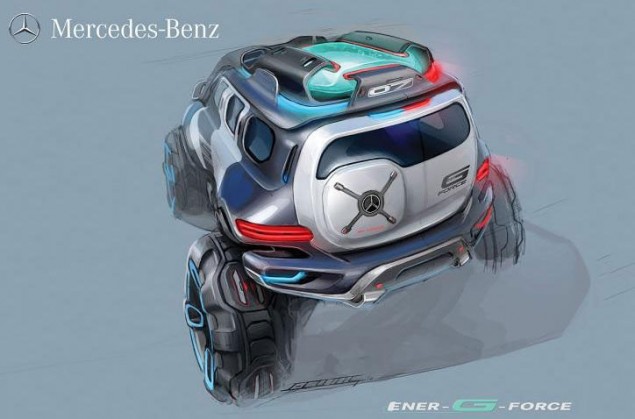
Design Team:
- Hubert Lee – Creative Director
- Jackson Luttig – Designer
- Sylvain Wehnert – Designer
- Armin Sinicki – 3D Sculptor
- Executive Design Support:
- Prof. Dr, h.c. Gorden Wagener – VP Mercedes-Benz Cars, Vans, and Trucks
- Mr. Steffen Koehl – Head of Advanced Design / Global Strategic Design
By 2025, law enforcement officers will need to adapt to even more crowded roads with electronically monitored and controlled traffic, a much larger population, and changes in human behavior. As the most environmentally friendly SUV, the “Mercedes-Benz Ener-G-Force” meets these requirements and helps police and crews around the world. In terms of design, the Ener-G-Force is based on the G-Class; the off-road icon that has been in production since the 1970s, and continues to shape the future as a structurally and technologically advanced SUV.
BMW Group DesignworksUSA – Vehicle Title: DesignworksUSA E-Patrol (Human-Drone Pursuit Vehicle)
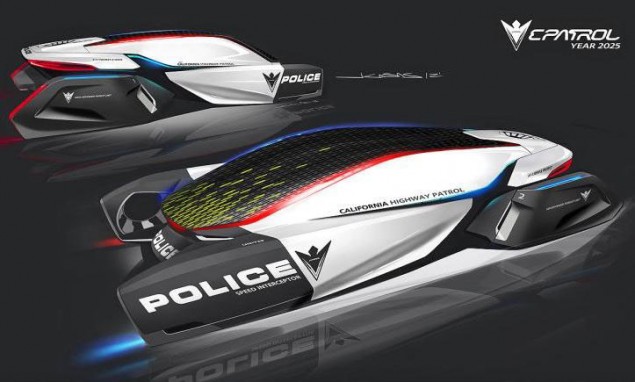
Design Team:
- Jose Casas – Designer
- Won Awe – Designer
The BMW Group DesignworksUSA team chose Los Angeles as the region to create a 2025 scenario for the E-Patrol (Human-Drone Pursuit Vehicle). Their research predicted that Los Angeles would have more traffic, faster vehicles, and vehicles with alternative fuel sources. The design centered on a modular structure and drone technology that enhanced both teamwork and accessibility. The main structure can deploy three drones. In the case of a pursuit during heavy traffic areas, the patrol officer sitting in the two passenger main structure can deploy either the flying drone or one of the single wheel drones to chase the suspect and report back data to the main structure.
General Motors Advanced Design California – Vehicle Title: Volt Squad

Design Team:
- Frank Saucedo – Design Director
- Phil Tanioka – Design Project Manager
- Brent Wickham – Concept Strategist
- Charles LeFranc – Observe Vehicle Designer
- Shawn Moghadam – Pursue Vehicle Designer
- Darren Luke – Engage Vehicle Designer
- Thamer Hannona – Storyboard Designer
General Motors has created a new electric vehicle system, the Volt Squad, to meet the challenge of a highway system now brimming with cutting edge technologies. The Volt Squad is a three vehicle fleet, designed around the concept of OBSERVE, PURSUE and ENGAGE. Each vehicle has a clearly defined situational role; delivering superior flexibility, presence and capability for the CHP. At the core of the vehicle’s architecture is the VOLT advanced, electronic, propulsion system.
Honda R&D Americas, Inc., Advanced Design Studio, California – Vehicle Title: Honda CHP Drone Squad
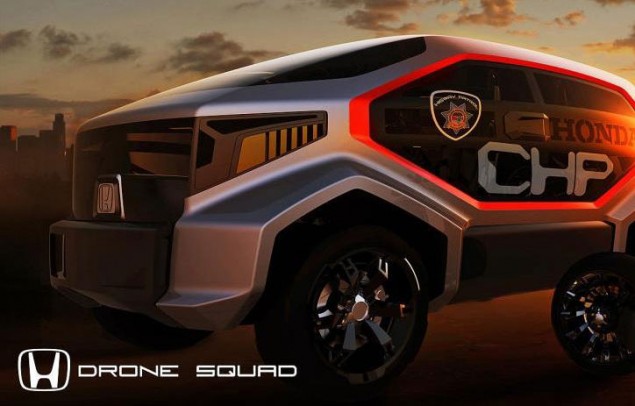
Design Team:
- Jason Wilbur
- Eddie Birtulescu
- Raj Rihal
Honda Advanced Design has created the CHP Drone Squad, a vehicle-based-system for 2025 designed to work efficiently and seamlessly in the harsh environment of California highways without the need for new infrastructure. The Drone Squad is comprised of a 2 vehicle system. The Auto-Drone operates as a manned or un-manned mission control vehicle which deploys Moto-Drones and can do so on the move. Moto-Drones are un-manned motorcycles capable of being rigged for multiple response or rescue missions.
Honda R&D Company, Ltd., Advanced Design Studio, Tokyo – Vehicle Title: Honda “CHiPs” 2025 Traffic Crawler
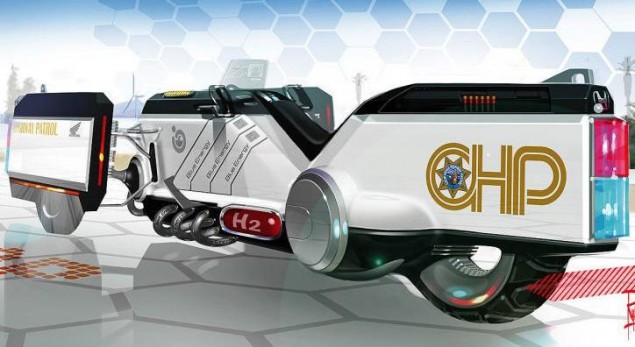
Design Team:
- Ryo Nakayama
Honda R&D Japan’s “CHiPs” 2025 Traffic Crawler offers key features that the central office of the California Highway Patrol needs as they adjust to changes in the traffic environment in 2025 where, in addition to conventional traffic problems, vehicles freed from environmental constraints are getting bigger. Despite the transition period to safe automatic driving, the traffic environment is again becoming confusing and challenging as California resumes its once flourishing car culture. In response to the need for strict traffic enforcement, Honda designed a new patrol vehicle that offers sporty mobility with the toughness to respond in severe traffic situations.
Subaru Research and Development, Inc. – Vehicle Title: SHARC (Subaru Highway Automated Response Concept)
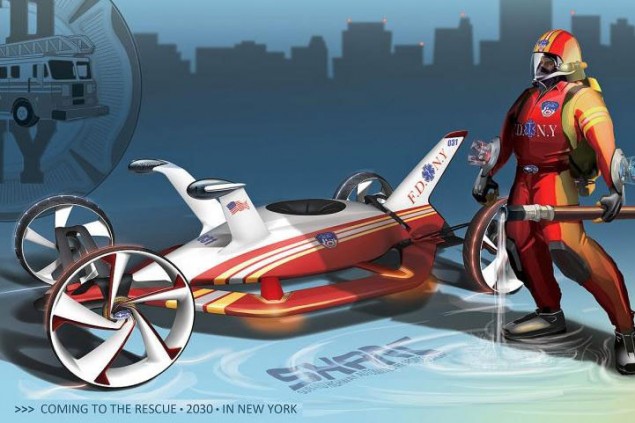
Design Team:
- David Cohen – Project Leader
- Matt Wherry – Vehicle Design
- David Cohen – Vehicle Design
- Masashi Kaneda – Character Design
- Digital Modeling :
- Teru Kobayashi
- Takamitsu Watanabe
- Hang Hui Yao
With the grand opening of Hawaii’s sparkling new inter-island Paradise Highway, Subaru debuts the cutting-edge SHARC (Subaru Highway Automated Response Concept). SHARC highway patrol vehicles will provide an innovative, affordable, and environmentally conscious solution for 24-hour highway monitoring, protection, and rapid emergency response. Meeting Hawaii’s strict UltraGreen carbon-neutral environmental regulations and reflecting a trend for reduced highway patrol budgets worldwide, zero-emission SHARC vehicles are powered by renewable energy and operate autonomously, eliminating the need for a large full-time highway patrol staff.
2025 Mercedes-Benz Ener-G-Force In-Depth
The 2025 Mercedes-Benz Ener-G-Force is the vision of an off-roader that, while reflecting tomorrow's adventures
The Mercedes-Benz G-Class became a civilian SUV in 1979, is it possible that it will still be around in 2025, keeping it’s title as the longest produced Mercedes-Benz in Daimler’s history? If the beloved G-Class is still in production for the next 15 years, it begs the question, what will the future G-Class look like?The most recent design study from Mercedes-Benz demonstrates how the genes of the classic off-roader may still assert themselves in the far future. It is based on the concept of a future police car developed for the Los Angeles Design Challenge.
The Los Angeles Design Challenge 2012 looks far ahead with a quest for the “Highway Patrol Vehicle 2025”. Law enforcement will have to prepare for even more crowded roads with electronically monitored and guided traffic, a much larger population and changes in human behaviour. People will feel young and active until even later in life. Outdoor activities will dominate leisure, the desire for freedom and adventure. The new times will also call for new police vehicles. They must be able to reach any place conceivable quickly and reliably – even far away from any pavement. And they must do so in an exceptionally environmentally friendly way using alternative energy sources. Enhanced green-car characteristics and off-road capabilities will be among the fundamental virtues of a police car in 2025.

2025 Mercedes-Benz Ener-G-Force
As an environmentally friendly SUV, the Ener-G-Force, which Mercedes-Benz is presenting in Los Angeles as a design study, meets these requirements and would be fully capable of supporting police and emergency services in every corner of the world. Gorden Wagener, Director of Design at Mercedes-Benz Cars: “The Ener-G-Force is the vision of an off-roader that, while reflecting tomorrow’s adventures, also invokes the genes of the Mercedes-Benz off-road icon, the G model. Modern and cool, it could also be a clue about a new beginning for the off-road design idiom of Mercedes-Benz”.
The small glass areas make the police vehicle a safe cocoon for law enforcement officers who are faced with many dangers. Emergency lights integrated into the roof ensure attention that is impossible to ignore; the striking front leaves no doubt as to the commanding presence of the police, and the gigantic wheels guarantee the right of way even where no way exists.
Back from the future – clean concept for beyond tomorrow
Of course the concept of the Ener-G-Force for the Los Angeles Design Challenge is pure, rendered science fiction. However, the notion of designing tomorrow’s off-roader fascinated the designers at the Mercedes-Benz Advanced Design Studio in Carlsbad, California to such an extent that they evolved the vision of a police version into a civilian version and even built a 1:1-scale model. Like the “Highway Patrol Vehicle 2025”, the shape of the civilian Ener-G-Force is modelled after the G-Class, the off-road icon whose continuous history goes all the way back to the 1970s and that to this very day still tackles the future as a stylistically and technologically advanced SUV.
Like the police version, the model of the civilian Ener-G-Force is unmistakably inspired by the G-Class, which has long been considered an automotive icon. However, it presents a radical reinterpretation of this classic that looks far into the future. Important genes such as proportions and design elements were adopted conceptually and completely redesigned and updated in a clean concept for beyond tomorrow. Ener-G-Force Designer Hubert Lee: “Of course we wanted to take a clear step forward, but we also wanted the G’s characteristic features”. The Ener-G-Force has a similar profile, however with a high shoulder line and scaled-down glass areas.

2025 Mercedes-Benz Ener-G-Force
While the clear design idiom of the G-Class has remained, all surfaces are designed to express intensity and tension. The meticulously executed details also are a clear indication that the Ener-G-Force is the product of modern times. Like the G-Class, the Ener-G-Force sports a front with an expressive radiator grille that incorporates the headlamps. LEDs in the headlamps form lamp units in the shape of a G. This gives the Ener-G-Force a strong, iconic appearance and demonstrates dominance. The front indicators and position lights are mounted on top of the wings as a significant G-Class element.
The mounted roof distinctive to the G-Class and the tripartite glass area also cite the fundamental genes of the classic off-roader from Mercedes-Benz, but represent a clear step forward. This is also evident in the large wheels, whose 20-inch rims give the Ener-G-Force a powerful, towering stance. The Ener-G-Force also plays on the utility factor in an entirely new way. For instance, the distinctive feature in the rear is a slightly off-centre pull-out compartment whose cover takes up the characteristic look of the spare wheel carrier of the classic G-Class. This pull-out tool box can hold a wide variety of equipment items that consequently are quickly in reach without having to open the whole liftgate.
Bursting with energy
The Ener-G-Force stores recycled water in tanks on the roof, and transfers it to the “hydro-tech converter,” where natural and renewable resources are converted into hydrogen for operating the fuel cells. The storage units for the electricity generated in this process are housed easily accessible in the striking side skirts. The Ener-G-Force emits nothing but water, has an operating range of about 800 kilometres and as a result truly is a green car. Four wheel-hub motors, whose output for each individual wheel is adapted precisely to the respective terrain by high-performance electronics, provide the pulling power. A “Terra-Scan” 360-degree topography scanner on the roof permanently scans the surroundings and uses the results to adjust the spring and damping rates as well as other suspension parameters for maximum traction on the respective surface, regardless of whether it is in terrain or on the road. The strikingly styled side skirts house either the energy storage units or hot-swappable battery packs. Changes in the colour of the illumination of the side skirts indicate the operating and charge status of the energy packs. A roof carrier and additional lamps are integrated into the roof. The ensemble appears to have been carved from a single piece. The overall package of this design model is a clean thing – stylistically and functionally.
smart 341 Parkour Wins the Los Angeles Design Challenge 2011
For the smart 341 Parkour, Mercedes-Benz designers created a super all-rounder with a completely transparent passenger cell
This year’s Los Angeles Design Challenge was not just about developing the Hollywood car of the future, but also about inventing a story worthy of Hollywood. Thanks to the ingenious work from the designers at the Mercedes-Benz Advanced Design Studios in Sindelfingen, the smart 341 Parkour won the design contest. “With the 341 Parkour, smart hit the nail on the head: the design combines innovation and functionality with an exciting film plot” is how the jury consisting of multi-discipline design professionals justified their decision.
With the smart 341 Parkour the Mercedes-Benz designers created a revolutionary super all-rounder with a completely transparent passenger cell for maximum all-round visibility. It can drive normally on the roads, climb up the façade of skyscrapers and even fly! This is the vehicle that reporter Annie Angle sets off in to research her first title story which she hopes will kick-start her career. She has read in the newspaper that the incredible “smart Granny Robots” have gone missing and sets off to find them.
For the film story the designers took up the visionary smart concept which won them first place in the Los Angeles Design Challenge last year. Then the smart 454 was knitted from carbon fibre by “smart Granny Robots”.
Smart 341 Parkour – Annie get the Grannies!
In a world of continuous change, in Cantpark City, reporter Annie Angle is beginning a new chapter in her life. Cantpark City is famous for its friendly people, the beautiful weather, but notoriously known for a lack of parking spaces. On an early Sunday morning, an article in a newspaper catches Annie’s eyes… “Smart Granny Robots missing!!!”
Annie sets off on a journey to solve the mystery of the missing Grannies and to earn her first, potentially career-making, front page news article. Her Smart 341 Parkour vehicle plays a key role in this private investigation, providing both effective transportation and favourable sleuthing capabilities.
Several features enable her to take pictures from the best possible locations. The large greenhouse gives Annie 360 degrees of visibility while travelling through the inner city. The wheels are retractable and contain impulse pads and vacuum cups. The hexagon skin around the wheelhouse is adjustable to release the wheels. The Smart has different modes: a typical drive mode, a fly mode that allows the vehicle to hover far above the streets and a climb mode that allows the vehicle to run up the walls of skyscrapers.
The film for Mercedes-Benz “Silver Lightning” has been awarded as “Best Animation”.
Mercedes-Benz, Maybach and smart at the Design Los Angeles Challenge
The Mercedes-Benz Silver Arrow has proportions reminiscent of the Mercedes W125 series, a Silberpfeil racecar of the late 1930's
For the past eight years, the Design Los Angeles Board of Directors – made up of twelve design studio executives – have chosen a theme for the the LA Auto Show’s Design Challenge. This year’s chosen them is “Hollywood’s Hottest New Movie Car” and design studios from around the globe have been invited to participate and submit their designs. Studios from Germany, Japan and the U.S have chosen to compete including Mercedes-Benz, Maybach, smart, Honda, Subaru and Hyundai.
How the vehicle reflects its brand attributes relative to the movie plot; how the vehicle relates to the targeted audience or brand; the level of imagination; the character development of the vehicle; and the uniqueness of the combination of story, car and character are the various factors that the entries are judged on.
Mercedes Silver Arrow- Silver Lightning
In homage to 125 years of automotive innovation and design excellence, Mercedes-Benz Advanced Design of North America features a story with two techno characters that have achieved a unique harmony between safety and style; the iconic Mercedes-Benz Silver Arrow racecar, and the underappreciated ‘Crash test dummy.’
In a futuristic society of increased artificial intelligence, two enlightened crash test mannequins, Hans05 and Franz02, show that they’re no dummies when it comes to recognizing a potential catastrophe and decide to take matters into their own hands. As the evil battering ram Dr. Crash-Barrier seeks to continue his reign of terror and mayhem, the two heroes take action to save their beloved Mercedes-Benz Silver Arrow. They lead the relentless ‘Dr. Barrier’ on an action packed thrill ride through the past and future of transportation.
A long-slung, sculpture on wheels – actually on ‘Hoops’ – the Mercedes-Benz Silver Arrow has proportions reminiscent of the Mercedes-Benz W125 series, a Silberpfeil racecar of the late 1930’s and the Uhlenhaut SLR from the 50’s. The overall shape follows distinguished Mercedes-Benz design traditions and is born from a dominant Formula 1 racing legacy. It also features a diagonally configured, hub-less roller track for ‘Omni-Directional’ maneuvering.
Brought to you by the creators of ‘Biome, a car grown from trees’, this epic adventure has it all, including a surprise ending that will have audiences cheering as our reluctant heroes save the day with a little old- school subterfuge and help from the great tradition of the Mercedes-Benz automobiles.
Maybach Berline- Cinderella and the Maybach Berline
Berline Carriage Engineer, her Stepmother, a retired Actress, and her Stepmother’s spoiled daughter who spent her days partying at the Billionares Club while Cindy spent all day working at her father’s workshop.
On the night of her birthday, Cindy’s father surprises her with a beautiful dress and allows her to take a new Maybach prototype out on the town – a reinterpretation of the historic Berline Carriage. Based on the dimensions of a Mercedes-Benz GL-Class, the Maybach Berline Carriage is an E-Cell or F-Cell vehicle and features autonomous driving that allows Cindy to have an amazing night out, where she meets a handsome stranger.
The Carriage is teleoperated via a satellite link to a Maybach Virtual Chauffeur Center. This leaves maximum interior space for the passengers and also allows maximum privacy. The passengers are seated in a vis-à-vis seating layout with a “Royal Lounge” on one side and two single seats on the other. A large glass screen with 3D laser projection is suspended from the ceiling and can display the Virtual Chauffeur or a variety of media and entertainment. The interior and exterior come together seamlessly and are comprised of sustainable materials like wood. Large divided gullwing doors with oversized privacy glass open wide for entry with retractable stairs for convenient entrance (inspired by business jets).
Moviegoers will awe in the romance and new technology as Cindy goes on the journey of a lifetime.
Smart 341 Parkour- Annie get the Grannies!
In a world of continuous change, in Cantpark City, reporter Annie Angle is beginning a new chapter in her life. Cantpark City is famous for its friendly people, the beautiful weather, but notoriously known for a lack of parking spaces. On an early Sunday morning, an article in a newspaper catches Annie’s eyes… “Smart Granny Robots missing!!!”
Annie sets off on a journey to solve the mystery of the missing Grannies and to earn her first, potentially career-making, front page news article. Her Smart 341 Parkour vehicle plays a key role in this private investigation, providing both effective transportation and favourable sleuthing capabilities.
Several features enable her to take pictures from the best possible locations. The large greenhouse gives Annie 360 degrees of visibility while travelling through the inner city. The wheels are retractable and contain impulse pads and vacuum cups. The hexagon skin around the wheelhouse is adjustable to release the wheels. The Smart has different modes: a typical drive mode, a fly mode that allows the vehicle to hover far above the streets and a climb mode that allows the vehicle to run up the walls of skyscrapers.
Follow Annie’s investigative search in Smart’s “Annie get the Grannies!” this November.
Maybach eRikscha Could be the Luxury Model for Tomorrow’s Urban Mobility
Maybach DRS “Den-Riki-Sha” combines ultralight design with a uniquely luxurious exterior and interior with electric drive
Stuttgart’s Maybach Manufaktur automotive hand-finishing section is exploring radical new avenues for the urban mobility of the future. As seen at the the Los Angeles Design Challenge with the electrically powered luxury rickshaw. The Maybach DRS – “Den-Riki-Sha” (electrically driven rickshaw) – blends the very latest automotive technology, luxurious comfort, and the highest safety levels with the needs of an environmentally aware world and the traditional values of the classic “Jin-Riki-Sha” (human-powered rickshaw). The futuristic four-seater is created through metamorphosis from a DNA cocoon, making it the world’s first naturally manufactured vehicle. The rickshaw was developed by the designers at the Mercedes-Benz Advanced Design Studios in Tokyo.
The challenge set before designers at Maybach was to draw a complete vision of a car that weighs 1,000 pounds (around 454 kilogrammes) (kerb weight). The remit was to create a four-seater small car that was safe and comfortable, offering good handling and first-class design. “This was a major challenge – in particular for a brand such as Maybach, whose luxury has thus far manifested itself not least in the vehicles’ size. This is why, when building the Maybach DRS, we combined the European concept of luxury with the Asian feel for optimum use of space, so we were able to create a vehicle which blends both in an intelligent manner. Thereby we have shortly undermatched the weight limit”, explained Holger Hutzenlaub, who heads the Mercedes-Benz Advanced Design Studios in Tokyo.
The amalgamation of organic intelligence and biomechanical engineering artistry
Breathtaking looks, polished luxury, and technical brilliance characterise the ambitious development of the Maybach DRS. The design is reminiscent of a butterfly’s cocoon, light and elegant as it floats between two oversized wheels. The rickshaw is made in a unique, natural production process. Through a complex and perfect metamorphosis a finished vehicle is developed from a DNA cocoon: Organic intelligence blends with advanced biomechanical engineering. The result is a futuristic combination of an ultralight structure and an unparalleled luxury exterior and interior – for a limited number of exclusive vehicles.
The vehicle frame consists of carbon fibres and organic composite materials, whilst the doors and windows are made of injection-moulded polycarbonate and the panoramic roof of flexible organic composite materials. The Maybach DRS is powered by two 20 kW electric motors which are positioned in the wheel hubs and are self-balancing. The energy required is produced by a lithium-ion battery in the tail end. An on-board computer ensures optimum control, communicating with the metropolis’s transport infrastructure, and thus guaranteeing a smooth, luxurious ride through the city. In order to increase the vehicle’s range, the human/electric hybrid also allows additional pedal force, which is produced by the driver.
Staying true to the grand Maybach tradition of luxurious mobility, the Maybach DRS – “Den-Riki-Sha” – is carrying forward this heritage, paying homage to the roads of tomorrow.
Mercedes-Benz Biome at the Los Angeles Design Challenge
The Mercedes-Benz BIOME grows in a completely organic environment from seeds sown in a nursery
At this year’s Los Angeles Design Challenge, the designers from the Mercedes-Benz Advanced Design Studios in Carlsbad, California, surprised everyone with a revolutionary vision. Taking their inspiration from nature, they designed a vehicle which is fully integrated into the ecosystem, from the moment of its creation right through to the end of its service life. The Mercedes-Benz BIOME grows in a completely organic environment from seeds sown in a nursery. Out on the road the car emits pure oxygen, and at the end of its lifespan it can be simply composted or used as building material.
“As the inventor of the motor car, we wanted to illustrate the vision of the perfect vehicle of the future, which is created and functions in complete symbiosis with nature. The Mercedes-Benz BIOME is a natural technology hybrid, and forms part of our earth’s ecosystem. It grows and thrives like the leaves on a tree” according to Hubert Lee, Head of the Mercedes-Benz Advanced Design Studios in Carlsbad. This year the competition had called for the creation of a vision of a safe and comfortable 2+2 compact car featuring good handling and a first-class design, and weighing only 1,000 lbs (around 454 kg/kerb weight).
Mercedes-Benz symbiosis – a partnership with nature
The Mercedes-Benz BIOME symbiosis vehicle is made from an ultralight material called BioFibre and tips the scales at just 875.5 lbs (around 394 kg). This material is significantly lighter than metal or plastic, yet more robust than steel. BioFibre is grown from proprietary DNA in the Mercedes-Benz nursery, where it collects energy from the sun and stores it in a liquid chemical bond called BioNectar4534. As part of this process, the vehicle is created from two seeds: The interior of the BIOME grows from the DNA in the Mercedes star on the front of the vehicle, while the exterior grows from the star on the rear. To accommodate specific customer requirements, the Mercedes star is genetically engineered in each case, and the vehicle “grows” when the genetic code is combined with the seed capsule. The wheels are grown from four separate seeds.
The Mercedes-Benz BIOME is powered by BioNectar4534, which is stored in the BioFibre material of the chassis, interior, and wheels. In addition, Mercedes-Benz has developed a technology to equip trees with special receptors which can collect the excess solar energy and turn it into BioNectar4534. This creates a direct link with nature’s energy sources and acts as an incentive to cover mobility energy requirements through more trees and at the same time maintain natural resources. Like plants, the Mercedes-Benz symbiosis vehicle also produces oxygen, thereby contributing to improving air quality. At the end of its service life, the Mercedes-Benz BIOME can be fully composted or used as building material. Thanks to the exclusive use of green technologies, the BIOME vehicle thus blends seamlessly into the ecosystem.
Los Angeles Design Challenge
The Los Angeles Design Challenge is part of the Design Los Angeles conference, taking place from 17 to 18 November 2010 as part of the Los Angeles Auto Show. The winner of the competition will be announced on 18 November 2010.